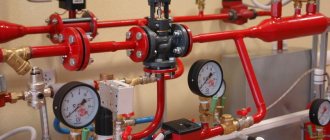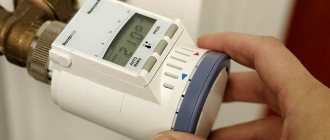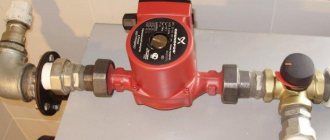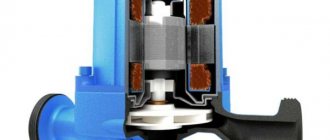It is impossible to live in unheated rooms in winter and no one argues with this. Hot radiators during the colder months are a common benefit of modern life. However, the bills regularly calculated by heating management specialists are often inflated, aren’t they?
Have you decided to figure out how to install heating meters in your apartment in order to get a real chance of not paying extra, but don’t know where to start?
We will help you study this issue in detail - the article describes the procedure for installing a meter and the interaction of the owner with the heat supply organization. The main types of meters and their features are also discussed.
The article is supplemented with thematic photos and useful video advice from owners who, through the courts, proved their right to pay only for the heat actually consumed.
Monthly payments for someone else's living space
Each apartment building must be equipped with a heat meter - Article 13, paragraph 5 of Federal Law No. 261-FZ of November 23, 2009 .
The management company fulfills this condition and, based on the results of each month, records the heat consumption for the high-rise building under its management.
The amount for thermal energy is simply divided between apartments according to their living space. Although this approach cannot be fair.
Good money is spent on heating bills. And half of them are wasted
The data on living space available in the Criminal Code are based on the technical passport of each apartment. However, such technical data sheets often do not take into account data on apartment redevelopments that increase the heating area.
It does not contain information about increasing connection points for heating radiators.
Meanwhile, apartments with redevelopment and an expanded number of heating devices consume more heat than others.
And since the general building consumption of thermal energy is divided according to the registered living space, residents of “ordinary” apartments pay for the heat consumed by residents of “improved” apartments.
Individual heat meter on the horizontal heating circuit of the apartment
A simple way out of the situation with paying for someone else’s heat is individual meters on the heating circuits of apartments.
Cost savings on thermal energy, the consumption of which is determined by a heat meter, will amount to over 30% of previous heating payments tied to the size of the living space (standard).
What you need to consider before installing a heating meter in your apartment
The placement of heat meters in houses in the Russian Federation is regulated by Federal Law No. 261, which obliges the installation of common household devices that take into account heat costs. Installation is carried out at the expense of associations of apartment owners, the so-called condominium associations. The payment method and methodology for calculating services in houses with an installed heat meter are regulated by Resolution of the Cabinet of Ministers of the Russian Federation No. 354. The main points of this resolution include the following:
- If there is no thermal energy calculation device at the entrance to an apartment building, payment for heat supply is calculated using an increased coefficient, which in 2022 was equal to 1.5.
- According to the laws of the Russian Federation, the owner of the apartment is not obliged to install a heat meter in the apartment, but there are also no laws prohibiting the performance of such work.
- Heat meter readings for heating in an apartment will be taken into account only in a building where not only 100% of the apartments, but also heated common areas are equipped with heat meters. The installation of a common metering unit in the house is also considered a prerequisite.
- A personal-use device is commissioned by a heat supplier and serviced by its employees. Repair, verification or replacement of the heat meter is carried out at the expense of the apartment owner.
An individual heat meter is serviced by the supplier company at the expense of the owner
From the above theses it follows that the installation of a common heating unit in a house is considered mandatory, because otherwise heating services may increase by 1.5 times, and the data from the personal meter will not be taken into account at all. For these reasons, there is no point in installing heating meters in an apartment if there are rooms in the house with uncontrolled heat consumption.
Important! According to the law, a utility provider may allow the installation of a device, but when drawing up a payment, it has the right not to take into account the obtained indicators. Therefore, these kinds of nuances need to be decided in advance - before installing the meter, so as not to end up with senseless waste.
In some cases, if there is no technical capacity to install a common house unit that controls the flow of heat into the house, an official certificate is issued confirming the impossibility of carrying out the work. Therefore, the only correct option is to install a heat meter in the apartment and separately in the entrance, because an individual device does not take into account the consumption of thermal energy spent on heating non-residential premises, which includes:
- staircases and landings;
- Technical buildings;
- basements;
- storage rooms.
Related article:
Screen for a heating radiator: a protective and decorative element in the room
What is he like? Element functions. Types of gratings depending on the design, mounting option and material of manufacture.
Types of residential heating system wiring
Apartments in high-rise buildings are equipped with either vertical or horizontal distribution of the heating system. In apartment buildings built before the beginning of the 21st century, heating systems were installed vertically.
Option #1 - vertical wiring
The vertical circuit of the thermal system is made of one pipe, less often two pipes. But always with a sequential flow of coolants through the interfloor levels - from bottom to top, then from top to bottom.
Vertical heating distribution is especially common in Khrushchev-era buildings.
The circuit of a single-pipe thermal system covers several floors and apartments. That’s why you can’t install a built-in heat meter on it
Heating with vertical wiring has serious disadvantages:
- Uneven heat distribution . The coolant is pumped along a vertically oriented interfloor circuit, which does not ensure uniform heating of rooms at different levels. Those. in apartments on the lower floors it will be noticeably warmer than in rooms located closer to the roof of a high-rise building;
- Difficulty adjusting the degree of heating of heating batteries. The need to equip each battery with a bypass;
- Problems with balancing the heating system . The balance of single-circuit heating of vertical distribution is achieved by adjusting shut-off valves and thermostats. But at the slightest change in pressure or temperature in the system, the adjustment must be made again;
- Difficulties with individual accounting of heat consumption . There is more than one riser in the vertical heating system of apartment rooms, so conventional heat meters cannot be used. You will need several of them for each radiator, which is expensive. Although for vertical heating, another thermal energy metering tool is available - a heat distributor.
Constructing a vertically oriented heating pipeline was cheaper than horizontal wiring - fewer pipes were required.
Such savings in the era of mass standard development of urban areas of Russia in the 20th century were considered completely justified.
Option #2 - horizontal wiring in a high-rise building
When the heating system is laid out horizontally, there is also a vertical supply riser that distributes the coolant across the floors.
The pipe of the second riser, which serves as a return line, is located in a vertical technical shaft next to the supply riser.
From both distribution risers, horizontal pipes of two circuits are led into the apartments - supply and return. The return line collects cooled water, transporting it to a thermal station or heating boiler.
In a horizontal heating circuit, everything is simple - the coolant enters the apartment through one pipe, and exits through the other.
The advantages of horizontal distribution of heating pipes include:
- the ability to regulate the temperature in each apartment , as well as throughout the entire highway (installation of mixing units is required);
- repair or maintenance on a separate heating circuit without completely shutting down the heating system. Shut-off valves allow you to close the apartment’s circuit at any time;
- quick start of heating on all floors . For comparison, even in a well-balanced single-pipe vertical distribution system, delivery of coolant to all radiators will take at least 30-50 seconds;
- installation of one heat meter per apartment circuit . With horizontal heating distribution, equipping it with a heat meter is a simple task.
The disadvantage of a horizontal heating circuit is its increased cost. The need to install a return pipe parallel to the supply pipe increases the price of residential heating by 15-20%.
Types of metering devices
All heat meters for heating existing on the market are divided into several types.
Tachometric/mechanical
Measures the amount of thermal energy passed through the pipe using a rotating element. Its active part can be in the form of a screw, turbine or impeller. It is accessible and easy to use. Among the disadvantages of the flowmeter, poor resistance to contamination (for example, rust, dirt settled inside) and water hammer is noted.
Ultrasonic
Often used as a heat meter for apartment buildings. There are several types: Doppler, time, frequency. Its work is based on the principle of delivering ultrasound through the water column. The signal is emitted by the transmitter and caught by the receiver. The device is highly accurate.
Electromagnetic
A high-precision device that operates on the principle of passing a magnetic field through a coolant flow. Requires periodic maintenance and cleaning. Consists of temperature sensors, electronic unit and measuring transducer.
Vortex
A device consisting of a triangular prism, a measuring electrode and a magnet installed outside the coolant. It works on the principle of creating a vortex behind an obstacle. It is not sensitive to blockages, but reacts negatively to air flows in the system. Mounted between two pipes in a horizontal position.
Features of the main types of meters
A group of individual heat energy metering devices is designed to work in heating networks with a pipe channel diameter of 15-20 mm and a coolant volume in the range of 0.6-2.5 cubic meters per hour.
Heat meters and heat distributors perform calculations of consumed thermal energy independently, with data displayed on an electronic display.
Horizontal distribution of heating pipes allows you to install the heat meter covertly, in a communication niche or shaft
The computing module of the device determines the amount of heat consumption for a given period of time (hour, day or month), storing and accumulating this information in the device’s memory for 12-36 months.
The most convenient way is to install a non-volatile heating meter (i.e. with an additional power source - a battery).
Depending on the heat meter model, its measurement values are displayed as kilowatts per hour, megawatts per hour, gigajoules or gigacalories. Management and other utility companies require heat readings in Gcal.
To convert to gigacalories, you must apply the appropriate conversion formula. For example, for kilowatts per hour - multiply the value by a factor of 0.0008598.
Each meter is a complex of several devices. Its kit may include temperature sensors, calculators for the volume of consumed thermal energy, as well as pressure, flow and coolant resistance transducers.
The exact configuration of the heat meter is set by the manufacturer for a specific model.
It is convenient to install a heat meter at the final stage of installing an apartment heating system
Depending on the principle of accounting for consumed thermal energy, heat meters are equipped with an ultrasonic or mechanical (tachometer) flow meter.
Models of devices with other types of flow meters (for example, vortex or electromagnetic) are also available, but they are not widely used. Heat meters are designed to collect information on heat consumption exclusively on the horizontal distribution of the heating circuit.
A separate group of heat meters are calculators and heat distributors that do not require insertion into the heating circuit. These devices are used to calculate the heat costs of heating radiators for any heating circuit diagram.
Type #1 - mechanical version of the flow meter
The simplest type of design, therefore the cheapest (about 9,000-10,000 rubles) is a device with two wired temperature sensors, a water meter and an electronic computer unit.
The main working element of the meter is a part (impeller, turbine or screw) that rotates as coolant passes through the device. The number of rotations determines the volume of coolant passing through the meter.
The installation procedure for a heat meter is seemingly simple, but the efficiency of the device depends on its quality.
Contact thermometers are built into the supply and return pipes of the heating circuit of the apartment. The first thermometer is placed in the meter, in a special socket.
The second is installed on the return pipeline, in a ball valve of a special design (with a socket) or in a tee equipped with a sleeve for a thermometer.
Advantages of mechanical heat meters:
- cost about 8,000 rubles;
- the design is simple and reliable;
- no external power supply required;
I am attracted by the fairly correct stability of the indicators and the permissibility of installation in a horizontal or vertical position.
Disadvantages of mechanical type heat meters:
- Guaranteed operation period is no more than 4-5 years - verification is required every 4 years;
- high wear of rotating parts - however, all mechanical meters are repaired for little money;
- increase in pressure - the rotating element increases the pressure in the heating circuit;
- susceptibility to water hammer;
- high need for the actual coolant flow rate in the heating system to match the nominal flow rate set by the manufacturer.
It is mandatory to integrate a coarse magnetic mesh filter into the circuit in front of the mechanical heat meter. The device is extremely sensitive to the content of mechanical suspensions in the coolant volume!
Type #2 - ultrasonic heat meter
These devices determine the coolant flow using an ultrasonic signal emitted by the emitter and received by the receiver.
Both elements of the thermal ultrasonic meter are mounted on a horizontal heating pipe, and a certain distance is established between them.
The signal from the emitter follows the coolant flow and reaches the receiver after a period of time depending on the speed of the coolant in the heating circuit. Based on the time data, the coolant flow rate is determined.
It has no rotating elements. Therefore, the service life of such a heat meter is longer, and the heat data is accurate
Over 10 versions of ultrasonic flow meters are produced - frequency, Doppler, correlation, etc. In addition to performing basic tasks, an ultrasonic heat meter can have the function of adjusting the flow of coolant.
Advantages of ultrasonic heat meters for apartments:
- low price in the basic configuration - from 8,000 rubles. (domestic models);
- heat consumption data is displayed on the LCD display by pressing one button, which is convenient;
- operation of the device does not cause an increase in hydraulic pressure in the heating system;
Significant advantages include a long service life - more than 10 years (verification is necessary every 4 years) and power supply from a built-in battery.
The main disadvantage of ultrasonic heat meters is their sensitivity to the composition of the coolant. If it contains air bubbles and dirt particles (scale, scale, etc.), the device readings will be incorrect, and in the direction of increasing heat consumption.
For ultrasonic flow meters, there is one installation rule - the section of the pipeline in front of and after the device must be straight (the required total length of the straight section is more than a meter). Then the meter will provide correct data on heat consumption.
Type #3 - calculator and heat distributor
These devices measure the relative costs of thermal energy. Their design includes a thermal adapter and two temperature sensors.
Every three minutes, sensors measure temperatures on the surface of the heating radiator and in the room atmosphere, determining the difference. The collected information on heat consumption is summarized and displayed on the device screen.
There is no need to hide such a heat meter - it looks perfect in the modern interior of the room
Heat computers are programmed to operate on a specific type of heating radiator at the time of installation on it.
You may also be interested in information about the types of heating radiators and their characteristics, discussed in our other article.
All necessary coefficients and power indicators of the radiator are entered into the meter’s memory, which allows it to display data on heat consumption in kilowatt-hours.
The numbers indicated by heat distributors are displayed in conventional units. To convert them into kilowatt-hours, you should multiply the value of the readings by the rated power of the heating radiator and the coefficient corresponding to the type of heating battery.
The coefficient numbers are provided by the meter manufacturer based on the results of laboratory tests.
A heat spreader is similar to a heat calculator. They are distinguished by the inability of the distributor to count heat as kilowatts per hour. In general, the heat distributor is simpler than the computer
Calculators and heat distributors are placed to measure thermal energy on one heating radiator. Those. in an apartment where heating is metered using such devices, there should be as many meters as there are heating radiators.
Both types of meters are effective regardless of the residential heating scheme and the operating characteristics of the coolant used in the heating circuit.
Advantages of heat distributors and calculators:
- cost is about 2000-2500 rubles. - i.e. their installation is beneficial in small apartments equipped with five heating radiators or less (but more than 2);
- long service life without verification - 10 years;
- simple and quick installation on or next to the radiator housing;
- transfer of data from several heat meters via radio to a single controller that sums them up (the presence of a radio module depends on the device model);
A convincing argument in favor of installing such devices is the complete independence of measurement results from the quality of the coolant.
Disadvantages of apartment computers and heat distributors:
- the relative measurement error is up to 7-12% (the greatest error is characteristic of heat distributors), which is higher than that of “mortise” heat meters;
- Energy consumption data is correct if calculated from the results of measurements of several devices within the apartment. One computer is not able to correctly determine the heat consumption of the atmosphere from one radiator. Summary data across multiple instruments is required;
- Effective operation only on factory models of heating radiators. Those. any modifications to the factory configuration of the radiator when measuring heat with such heat meters are unacceptable.
The installation kit for installing a computer or heat distributor is selected according to the type of radiator on the body of which the meter will be installed.
Handicraft methods of installing the meter will worsen the quality of data collection. If there is no specialized mounting kit, it is more rational to mount the device next to the battery it serves.
Why is it necessary to install a heating meter in a residential area?
The lack of high-quality heating due to improper operation of the heating network often forces apartment residents to look for alternative heat sources. At the same time, the cause of poor heating is not always a breakdown in the heating network. Often, housing and communal services workers, in an effort to save money, tighten the valve, which reduces the flow of hot water, which is especially felt by residents of the upper floors of high-rise buildings.
Quite often, due to poor performance of the heating network, it is necessary to look for alternative heat sources
This results in insufficiently warm batteries and the need to use electric heating devices, which, in turn, entails increased energy costs. Heating in an apartment does not become cheaper. The result is that users have to overpay on all fronts.
Important! An installed and registered heat meter for the battery will allow you to pay only for the heat consumed by a particular apartment, and for nothing more.
Another reason for high payments is often the difference in the temperature of the water that comes out of the boiler room and the one that goes directly into the apartment. Often, the temperature of the water in the radiator is significantly lower than normal, which occurs due to heat loss on the main line due to poor insulation or damaged pipes. Even in this situation, all costs fall on the shoulders of the end consumer.
Sometimes the situation can be completely different when the radiators are so hot that you have to open the windows to ventilate the room. In this case, you have to pay, in fact, for heating the street, which is also not considered correct. Regulators, which are often installed together with heat meters for heating, will help you avoid problems.
Scheme of operation of a heating meter in an apartment
The main advantages of installing a heat meter in an apartment
The heat energy meter is mounted directly on the pipe through which heating enters the apartment, and calculates only the amount of heat actually used. If you additionally install a thermostat to the device that controls the flow of water, you will be able to control the flow of hot water, which can be reduced if necessary. As a result of the work done, the final consumption figure will be significantly lower than that determined by the standards.
After installing and registering a heat meter in an apartment, you can be sure that only the costs of heating the home will be taken into account in the payment. You will not have to pay for heat losses during transportation or associated costs resulting from poor-quality services provided by the heat generating company after installation. Heat metering is carried out based on the following indicators:
- consumption of hot water delivered to the apartment;
- water temperature at the entrance to the heating system and at the exit from the apartment.
As a result of expenses, the amount of heat consumption per day, month or year, calculated in hectacalories, is determined. Modern apartment heat meters have the ability to store data on monthly heat consumption for a long period, usually up to 10 years. Some devices have an additional option that allows you to connect it to a computer and transmit readings via the Internet.
The main advantage of the meter is the ability to significantly save money
If there is any doubt whether a heating meter in an apartment is profitable, you can pay attention to a simple calculation: the price of the device together with installation is from 7 thousand rubles, and the minimum service life is 12 years. Over the course of one season, you can save from 4 thousand rubles on heating using a meter, which depends on the area of the apartment. Accordingly, over 12 years of use, at least 48 thousand rubles are saved, and this figure is far from final.
Helpful information! The only option when you should think about whether it is necessary and possible to install a heating meter in an apartment is if the housing has a vertical connection system and has not one riser, but several. In this situation, each riser needs its own meter, and this is already expensive. In such a situation, it is recommended to install one device per entrance.
The costs of operating the meter are insignificant, because basically you only pay for calling a specialist to check the device, which is carried out no more than once every 5 years. It is also sometimes necessary to replace the batteries, but this also has to be done by those who do not use the meter.
The procedure for legal installation of a heat meter
The sequence of actions aimed at installing an individual heat metering device in an apartment consists of several stages.
Let's look at them in more detail:
- A written application to the house management organization for permission to install a heat meter. Copies of documents on ownership of the living space and the technical passport of the apartment must be attached to the letter.
- Obtaining technical specifications for the installation of a heat meter from a heat energy supplier (usually a management company).
- Preparation of a project for individual heat metering and installation technical documentation. Performed by an organization that has the legal right to provide design services.
- Coordination of design documentation with the heat supply company.
You should not purchase a heat meter before receiving an agreed upon thermal energy project, because Failure is possible for various reasons.
Having all the documentation for the project, all that remains is to choose a heat meter - ultrasonic, mechanical or externally installed, for example, a heat calculator.
A device that is required to save up to 50% of heating costs - it must be installed by a professional. And with a guarantee
For the purchased model, you must obtain from the seller receipts (sales and cash receipts), instructions, warranty card and a copy of the current quality certificate.
The company installing the heat meter must have a license for this type of work.
Before choosing a contractor, it is necessary to evaluate the data on the candidates (Unified State Register of Legal Entities, certificates, SRO approvals), the professionalism of the installers (special equipment, list of installation work, availability of an installation kit), guarantees of the work performed.
The quality of the thermostat installed on the heating radiator is important. It is this that will allow you to control the heating of the battery, and therefore the cost of heat
Please note that in addition to the heat meter, you will need additional devices and accessories: bypass, radiator thermostats, pipe filters, tees, etc.
Sealing the heat meter or heat distributor after installation work is mandatory.
The seals are placed by representatives of the heat supply company.
Apartment heat meters per battery: what are they?
There are 4 types of residential heat meters per battery:
Tachometer heat meter for battery
- Tachometer (more often called simply mechanical)
- Ultrasonic
- Electromagnetic
- Vortex
The cheapest ones are tachometer ones. The average price of a heat meter per battery is 10 thousand rubles. Service life – no more than 4-5 years. Installation cost – at least 4 thousand rubles.
Ultrasonic heat meter for battery
Ultrasonic ones are more expensive, but not much. They provide greater accuracy of indicators and are not afraid of hard water.
Electromagnetic and vortex generators are expensive; they are bought mainly by industrial enterprises and large organizations.
It should be taken into account that if you have a vertical distribution of the heating main (that is, each battery has its own riser), then you will have to install a heat meter on each drain. For a three-room apartment - 4 pieces (counting the kitchen radiator). Total – 56 thousand rubles. This kind of money will not pay for itself over the service life of the meter.
Electromagnetic heat meter
Vertical wiring is used in old houses. Mostly Soviet-built. More modern residential buildings use horizontal wiring. This is when one supply pipe enters the apartment, on which all the batteries are “placed”, and then the used water comes out through the outlet pipe. In this case, the meter can pay off.
Installing a heat meter on a battery itself is not a simple matter. But the design of this event is no simpler. Necessary:
- Submit an application to the housing office and obtain permission to install a meter
- Draw up a meter installation project
- Approve the project in the Housing Office
- Install the meter
- Invite a housing office representative to seal the meter
And this is every 5 years!
Installation of a heat meter on a battery
Of course, if you order the installation of a meter from a contractor, they will perform the approval and permitting procedures for you. And another option is officially impossible: only certified organizations with the appropriate licenses can install residential heat meters on a radiator. No DIY!
What to do if the heating radiator is leaking? You will also find a solution to this problem on our website.
When is installation impossible or unprofitable?
The installation of an individual heat meter will be refused by the management company if the multi-storey building does not have a common building heat meter. To calculate the ODN coefficient, you need to know the heat consumption of the entire house.
Payments for a heat meter in the following situations will be higher than without it:
- the entry of the heating main into a multi-storey building was carried out according to an outdated scheme - through an elevator;
- the apartment is located at the end of the house, on the top or first floor;
- there are gaps in the window frames and in the front door frame;
- the loggia (balcony) is not glazed - insulating the balcony can help in such a situation;
- drafty entrance area (broken windows, ajar entrance door), etc.
Note that to minimize heat energy costs, it is not enough to install a common house and apartment meter. It is necessary to modernize the heating system of the building - replacing the elevator unit with AITP or AUU.
The ITP complex allows you to finely regulate the heating of the entire high-rise building. This means heating payments will decrease.
Only in such a high-rise building energy system will it be possible to achieve comfort in apartments with minimal heating payments.
Briefly about the main thing
Heating meters are devices that record exactly how much heat was spent heating the house. Thanks to them, you don't have to overpay.
They differ in size, purpose (for an apartment, a house, an entrance, an office, etc.) and design features. Each model has pros and cons.
Not all premises can have a heat meter installed. Before purchasing and installation, you must obtain consent from the management company.
Design, installation and subsequent inspection can only be carried out by specialists with appropriate licenses. Self-installation is prohibited, data will not be accepted.
What is a heat meter needed for and how does it work in an apartment building?
Heat meters are used to control the quality of heating services. If the radiators were not hot enough, then you will not have to pay the full price for heating your home.
Taking into account the constant increase in utility tariffs, an individual meter will help you save a lot. Such devices have long been installed at heating stations to monitor the quality of services.
Apartment buildings were also required to acquire heat meters to encourage them to take energy saving measures. Installing a heat meter allows you to check how correctly the coolant is supplied to the house, detect and eliminate possible losses from incorrect laying and wear of the heating main.
Rating of the best mobile phones for games
Rating of the best mobile phones for games and the Internet. Features of choosing a gaming smartphone. Main technical characteristics, CPU frequency, amount of memory, graphics accelerator.
Ratings
- 16.06.2018
- 864
How to transmit readings?
In order to pay your bill for actual water consumption and sewer fees each month, you must transfer the meter data to the appropriate service every month. In each region, this procedure is implemented in one of the following ways:
- the completed leaves of the subscription book are torn off and dropped into special boxes;
- water meter readings are entered on the water supplier’s website in the consumer’s personal account;
- An email with the data is sent to a special email address of the organization.
Vodokanal or DEZ may develop other methods of transmitting meter data. But the consumer chooses the option that is most convenient for him.
Now you know how to properly install a cold and hot water meter with your own hands, taking into account the features of the device and installation requirements.











